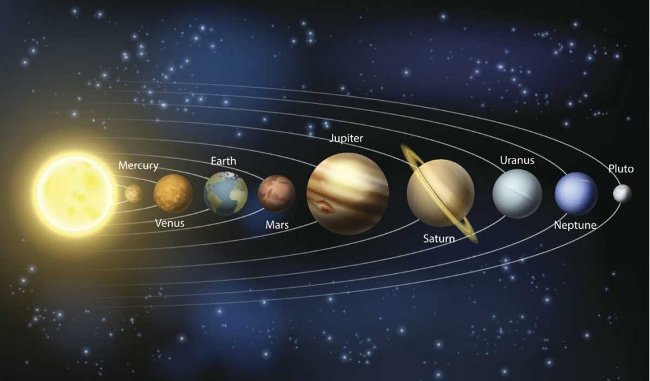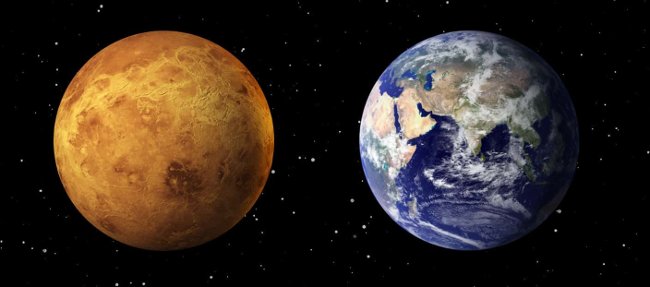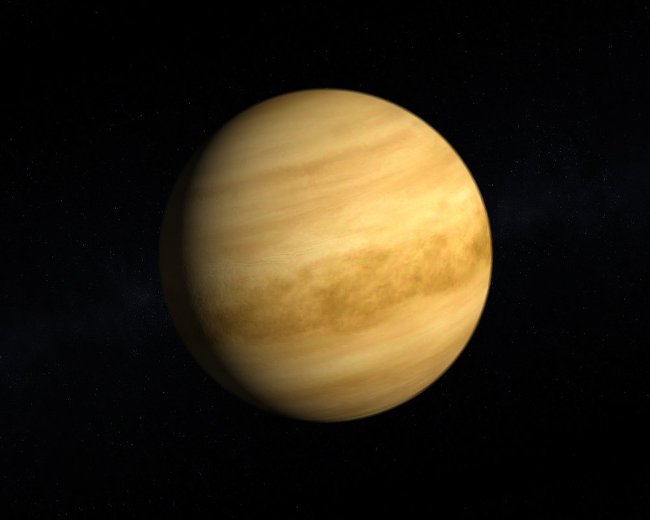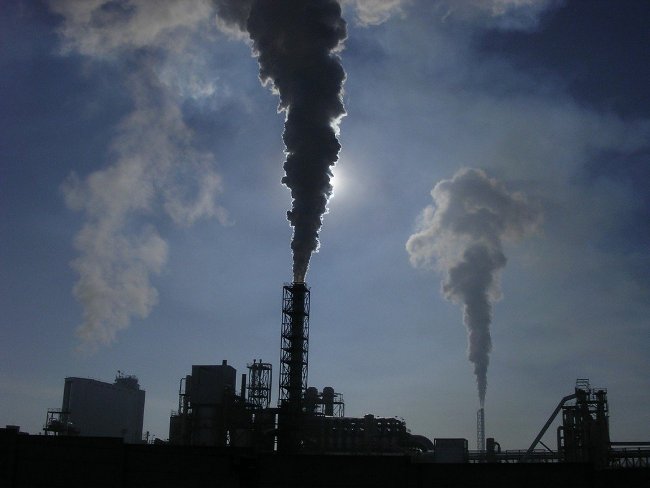The surface of Venus: Why is Venus the hottest planet in the solar system?
- Did you know: Mars, Venus has rotten egg smell and the Moon smells of gunpowder
- 40 interesting facts you didn't know about the Sun.
- The interesting fact about the universe is not quite the same as what we thought
Venus or Venus is the hottest planet in the solar system because the planet is covered by thick clouds containing carbon dioxide and other gases, which prevents heat from the Sun from escaping to outer space. That's why the second planet after Mercury absorbs heat from the Sun becomes hotter.
 Venus - the hottest planet in the solar system.
Venus - the hottest planet in the solar system.
The planetary chain revolves around the Sun in our solar system, Mercury is the planet closest to the Sun. Next to Venus and the third place is planet Earth - where we humans live.
Today, when applied in normal logic it seems that any planet near the Sun will suffer the largest temperature from the Sun and become the hottest right? However, interestingly, that logic is not applicable in this case.
Right! Although located in the closest position to the Sun, Mercury is not the hottest planet in the solar system . but why?

Things to know about Venus
Venus is the second planet from the Sun and is adjacent to our planet Earth. According to volume and size, Venus is similar to the planet Earth, sometimes Venus is also known as " twin planet " or " sister planet " with Earth.
Venus is classified as a terrestrial planet. Venus is surrounded by highly reflective thick clouds containing sulfuric acid and makes it impossible to observe its surface under visible light wavelengths. The air density in Venus's atmosphere is the largest of the four rocky planets, the main component being carbon dioxide.
 The size of Venus and the Earth is nearly the same.
The size of Venus and the Earth is nearly the same.
With a diameter of 12,014 km (7,465 miles ), Venus is only slightly smaller than our planet Earth and its mass equals 81.5% of Earth's mass. Venus does not have any natural satellites or rings, rotating from east to west, meaning in the opposite direction to most other planets.
Every planet in the solar system orbits in an anti-clockwise direction when viewed from the north pole of the Sun Most planets rotate around its axis in a counter-clockwise direction, but Venus rotates around the same clockwise clock ( called the inverse circumference ) with a 243-day Earth period - acceleration the slowest rotation of any planet in the solar system.
Internal structure
About 80% of Venus's surface is covered by flat volcanic plains, the planet also consists of two large continents - Ishtar Terra ( the northern hemisphere ) and Aphrodite Terra (the continent is right there) south equator planet ). The surface of Venus is relatively " smooth " than the surface of Mercury and Mars, the planet has a surface corresponding to the impact craters. However, it is particularly difficult to observe Venus with the naked eye due to thick gas clouds covering it from the viewers' view from a distance away.
 Venus.Photo source: Tristan3D / Shutterstock
Venus.Photo source: Tristan3D / Shutterstock
Because of the similarities in diameter and mass to planet Earth, astronomers believe that Venus's internal structure is similar to the planet Earth: including the central iron core, stone coating and shell ( like our planet ), but its magnetic field is weaker than Earth.
The surface of Venus
Venus's surface is constantly wavered by fierce volcanic eruptions. At present, cosmologists know nearly 1,600 volcanoes on Venus's surface, but in fact, there may be more simply because we humans are too small to be observed by Using existing technology and equipment. Moreover, the thick coating covered by thick clouds ( forming sulfuric acid ) spreads across the entire planet making it difficult for scientists to observe.
Now, come to the problem raised in the first part of the article - Venus's incredible heat! The temperature on Venus can reach 470 degrees C ( 870 degrees F )! This temperature is high enough to easily melt lead on the planet's surface.
Why is Kim so hot?

The maximum temperature of Venus can be created by its thick atmosphere. In fact, Venus has a very thick atmosphere, containing mostly CO2 and a small amount of N2. If you stay there, you will feel that the volume of atmosphere is about 93 times higher than that of Earth's atmosphere - this atmospheric pressure is equivalent to a depth of almost 1 kilometer from the ocean surface on the Earth. Land.
The CO2-rich atmosphere, together with the thick SO2 cloud, produces the strongest greenhouse effect in planets in the solar system, with a surface temperature of at least 462 ° C, making the surface of Venus hot. more than Mercury, with a minimum surface temperature −220 ° C and a maximum of 420 ° C. Greenhouse gases include methane, nitrous oxide, fluoric gases ( such as hydrofluorocarbons, perfluorocarbons, sulfur hexafluoride and nitrogen trifluoride ).
Even if the distance from Venus to the Sun is almost twice the distance from that to Mercury, the planet only receives about 25% of the solar radiation energy compared to the energy Mercury receives. Many people often describe the surface of Kim as a hot hell . This temperature is even higher than the required temperature in some sterilization processes.
 Some industries produce many greenhouse gases, which is the cause of great concern for people.Image source: Pixabay
Some industries produce many greenhouse gases, which is the cause of great concern for people.Image source: Pixabay
Because Venus's atmosphere consists mainly of carbon dioxide, heat from the Sun is difficult to escape from Venus's surface. Sunlight passes through the thick coating of carbon dioxide clouds and warms rocks on the surface of Venus.
However, the " bulky " atmosphere, rich in carbon dioxide, blocks infrared heat from these rocks to escape the planet, increasing Venus's temperature and making it the hottest planet in the system. Sun.
In contrast, Mercury, the planet closest to the Sun but not the hottest because it has no atmosphere to retain the Sun's heat. That heat has been " burned " for a long time. Therefore, although Mercury is most heavily influenced by hot temperatures from the Sun, due to the absence of the atmosphere, heat spills into space, making it the second hot planet in the solar system.
See also: How far is the distance from Earth to Mercury?

Venus reaches the maximum brightness right next to the sunset or dawn when viewed from Earth, so our folk are also called Homeland, when the planet grows at sunset and Morning Star , when the planet This grows at dawn.
In addition, Venus is also the brightest planet of the solar system when viewed from Earth. The special brightness of Venus is thought to be due to dense clouds, reflecting gas and sulfuric acid, allowing light rays to easily escape from them.
See also: What "horrible" thing will happen if the Earth suddenly stops spinning?
Having fun!
You should read it
- How hot is the planet of Mercury?
- The interesting fact about the universe is not quite the same as what we thought
- What happens if the plane takes off on 8 planets in the solar system?
- Admire the rare moment Venus and Jupiter 'meet' each other in the sky
- How big is the solar system?
- If 'stray' to any planet in the solar system, what is your chance of survival?
- Why NASA never wants to send people to Venus
- When can we determine the position of the '9th planet' in the solar system?
- Is the 9th planet in the solar system 10 times the size of Earth?
- How far is the distance from Earth to Mercury?
- How the Sun will look when viewed from other planets
- The unexpected truth about Uranus - the king of the sky
May be interested

Fire needs air to burn, so how does the rocket work in space?

The lost twin brothers of the Sun may be the culprits for the destruction of dinosaurs

2 more moons found around Jupiter

Video: Cassini spacecraft successfully performs the journey around Saturn

black hole, white hole, deep hole

How big is the solar system?






 How hot is the planet of Mercury?
How hot is the planet of Mercury? Why NASA never wants to send people to Venus
Why NASA never wants to send people to Venus If 'stray' to any planet in the solar system, what is your chance of survival?
If 'stray' to any planet in the solar system, what is your chance of survival? The interesting fact about the universe is not quite the same as what we thought
The interesting fact about the universe is not quite the same as what we thought How big is the solar system?
How big is the solar system? NASA declares the existence of the 9th planet in our Solar System
NASA declares the existence of the 9th planet in our Solar System